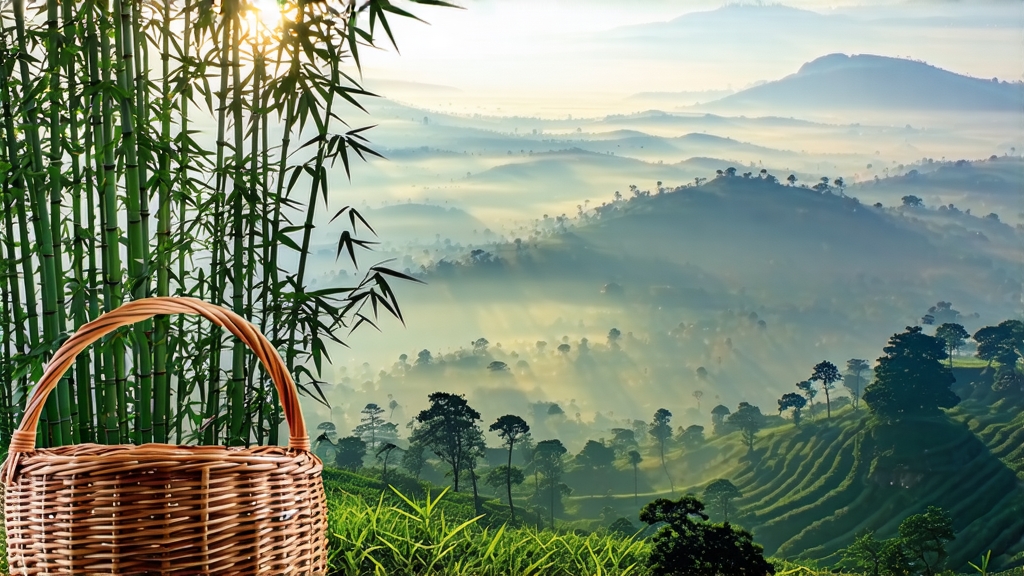
Tucked high on the mist-capped peaks of Mt. Mengding in Sichuan Province, Meng Ding Huang Ya—literally “Mengding Yellow Bud”—has been whispered about in Chinese tea chronicles for more than twelve centuries. Unlike the better-known green teas that surround it geographically, this yellow tea carries a whispered sweetness and a satin texture that once persuaded Tang-dynasty poets to call it “the dew of immortality.” Today, only a few thousand kilograms leave the mountain each spring, making it a living fossil of Chinese tea craft and a quiet luxury for those who insist that tea should taste of place, patience, and poetry.
History: From Imperial Tribute to Mountain Secret
The first written record appears in 808 CE, when the monk Wu Lizhen planted seven tea bushes on the summit as an offering to the Buddha of Wisdom. By Song times the buds were pressed into tiny cakes, wrapped in silk, and escorted by horseback to Kaifeng palace; Song Huizong, the artist-emperor, listed it among the three teas worthy of his “Tea of White Snow” ceremony. Ming dynasty tax registers show 560 liang of silver paid annually just to freight 24 kilograms down the Min River—more than the salary of a county magistrate. When loose-leaf fashion swept China in the 1700s, local monks adapted the cake recipe into the modern bud-only style, but kept the slow “sealed yellowing” step a cloistered secret. Thus, while Longjing and Bi Luo Chun conquered the empire, Meng Ding Huang Ya retreated into mountain fog, known only to Sichuan literati who climbed the 1,450 m pilgrimage path for a single cup.
Terroir: Where Clouds Polish the Bud
The garden zone sits just above the perennial cloud belt at 1,300–1,450 m. Morning mist refracts light, lengthening the amino-acid building hours; afternoon cloud cover cools the leaf, locking in fragrance. Granitic soils, rich in potassium and fluorine, force the roots to struggle, concentrating the sweet compound theanine. Temperature swings of 10 °C between day and night encourage slow growth: the standard picking window opens only between Qingming and Grain Rain—about fifteen days—when each bud has reached 18–22 mm but not yet unfurled. A local proverb says “three mornings of fog make one gram of yellow,” estimating that 7,000 fresh buds yield barely 200 g of finished tea.
Pluck & Craft: The Six Acts of Yellowing
- Dawn Pluck: Girls from the village of Ganxi descend before sunrise, shears hidden in bamboo sleeves to avoid metal taint. Standard: one bud, no leaf, no purple, no dew.
- Wind Withering: Buds are laid on hemp trays set inside stone alcoves where mountain wind blows through carved lattice; moisture drops from 78 % to 62 % in three hours, curling the tip like a parrot’s beak.
- Kill-Green: A 1.2 m diameter iron wok is heated to 160 °C with horse-dung charcoal (slow, even heat). Thirty seconds of tossing, ten seconds of pressing—eight cycles—until the aroma shifts from grassy to toasted chestnut.
- Rolling: No machine. A hemp cloth is twisted by two men in opposite directions, bruising the bud just enough to rupture 30 % of the cells; the liquor gains body without clouding.
- Sealed Yellowing: The heart of the art. The warm buds are piled 3 cm deep inside oak boxes lined with wet rice paper. Lids are sealed with cotton cloth and mountain stones. For 48–72 hours the pile hovers at 35 °C and 85 % humidity; chlorophyll degrades into pheophytin, polyphenols oxidize just 5 %, and a golden pigment forms. The tea master listens: when the rustle becomes a muffled “silk on silk,” yellowing is complete.
- Low-Temp Firing: Charcoal embers are covered with bamboo ash to hold 55 °C. Buds are dried for three hours, rested for one, then dried again; water content falls to 5 %. The finished leaf smells of fresh corn and orchid; color is yellow-green with golden down.
Grades & Styles
Imperial Bud (特级): 100 % single bud, length within 2 mm tolerance, down visible under 10×